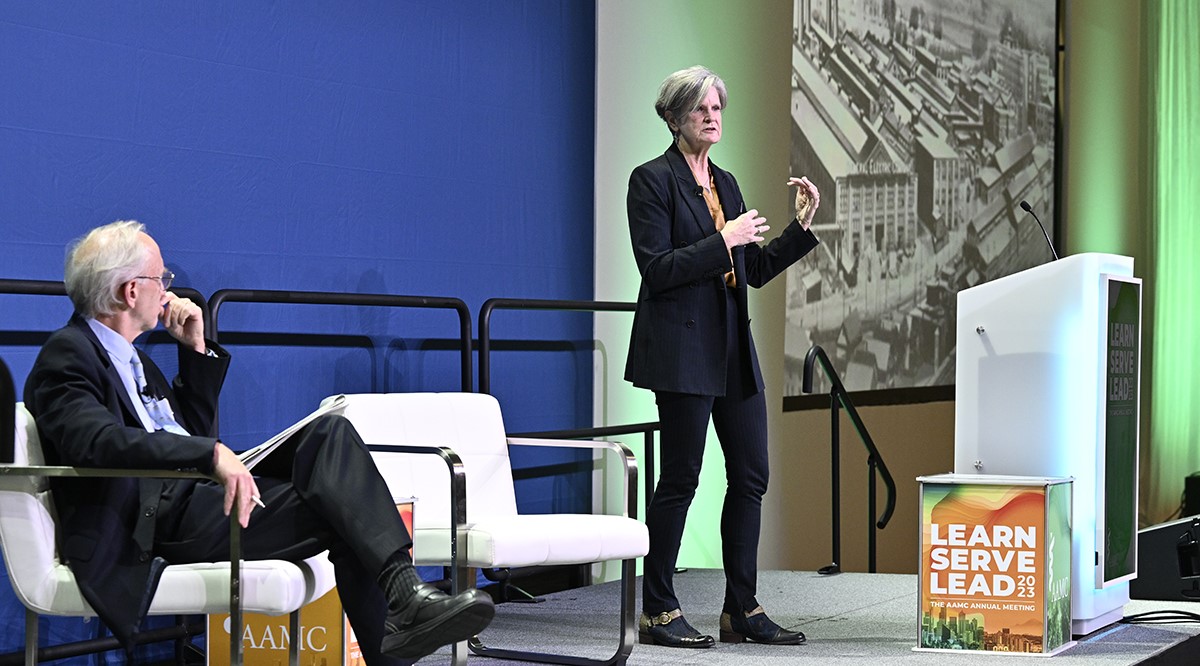
When Wendy Dean, MD, first argued that the term moral injury — severe distress from feeling forced to abandon one’s fundamental values — applied not only to wartime soldiers but also to doctors, she wasn’t sure how the idea would land.
But the psychiatrist was met with a flood of positive responses. In fact, the 2018 article Dean co-authored on the topic remains one of STAT’s top five most-read pieces.
In the article, the authors argued that provider distress went far deeper than what had previously been labeled burnout, Dean told listeners gathered at Learn Serve Lead 2023: The AAMC Annual Meeting on Nov. 5 in Seattle.
“Burnout is an incomplete diagnosis. It’s absolutely true that there is this demand-resource mismatch” that drains physicians. “But there’s this other thing that gets at the covenant that we made with society when we joined the profession that people were experiencing,” said Dean, co-author of If I Betray These Words: Moral Injury in Medicine and Why It’s So Hard for Clinicians to Put Patients First.
The phenomenon also includes a deep sense of betrayal, a betrayal caused by budgetary and administrative demands that too often seem to get placed above clinical judgment. In fact, a 2020 study of U.S. health care workers found that 45% felt betrayed by leaders at their institutions, said Dean, who co-founded the nonprofit Moral Injury of Healthcare to work on clinician distress.
What’s more, although the COVID-19 pandemic highlighted and intensified such issues, they plagued health care long before the pandemic, Dean said.
And the costs are tremendous. Among them are the more than 140,000 providers who have left health care in recent years and the patients who suffer when providers are not at their best.
Comparing physicians to high-performance automobiles, Dean noted that the fault lies much less in them than in the bumpy road they are asked to navigate.
“We need to get about fixing those potholes,” Dean urged in a conversation with listeners and with session moderator Walter O’Donnell, MD, director of the Center for Humane Innovations in Clinical Care at Massachusetts General Hospital in Boston.
For one, there is a dire need for greater collaboration between administrators and providers. Too often, health care is siloed, with administrators focused on keeping the institution afloat and clinicians focused on keeping patients healthy.
“I want you to ditch your scrubs and your suits,” and invest time in understanding the pressures each face, she said. Leaders are not hardhearted, she added, but they too often simply don’t know the obstacles physicians face, such as the frustration of pursuing insurance authorizations to get patients medications they need.
Providers can also work with their institutions to foster the traits of morally centered organizations. Those include humility, a genuine interest in feedback, and looking for lessons to learn when things go wrong.
Moving beyond the world of medicine, Dean noted that physicians can play a vital role by educating local, state, and federal legislators about the obstacles that cause moral injury. “If CEOs who have worked with doctors for years don’t know what our issues are, how can legislators possibly know?”
And she urged listeners to vote. “A lot of what we do is constrained by legislation and regulations, and voting is a way to change that,” she said.
Acknowledging the vast amount of work necessary, Dean suggested starting by reaching out to other clinicians. “The first thing is to talk about it. Are others in your organization struggling with the same issues? … Who is willing to start working toward change with you?”
And even small steps matter. “The bad news is medicine is really broken,” said Dean. “But the good news is that because it’s really broken, wherever you start to fix it, it will get better.”
